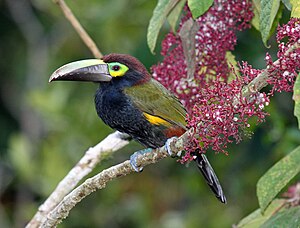Gel Bohrarassari
| Gel Bohrarassari | ||||||||||
|---|---|---|---|---|---|---|---|---|---|---|

Gelbohrarassari, female |
||||||||||
| Systematics | ||||||||||
|
||||||||||
| Scientific name | ||||||||||
| Selenidera spectabilis | ||||||||||
| Cassin , 1857 |
The yellow-eared toucanet ( Selenidera spectabilis ) is a bird art from the family of toucans. It occurs in Central and South America and is the northernmost species of the short-billed toucans . Like all representatives of this genus, the Gelbohrarassari shows a conspicuous sexual dimorphism , which is rarely found in the other toucan genera. No subspecies are distinguished. The IUCN classifies the Gelbohrarassari as ![]() (= least concern - not endangered).
(= least concern - not endangered).
Appearance
The Gelbohrarassari reaches a body length of 35 to 40 centimeters and a weight of 200 to 270 grams. Gelbohrarassaris are thus the largest representatives of the short-billed macaws. The males have a wing length of 12.5 to 15.4 centimeters. The tail length is 11.5 to 13.4 centimeters and the beak reaches a length of 8.3 to 10.2 centimeters. Females are similar to males in body dimensions, but have a slightly shorter beak with a length of 7.6 to 9.2 centimeters.
The males have a black head, a black neck and a blue-black underside. The ear mark is yellow. The back and wings are olive green. The tail is blue-gray and, unlike most short-billed macaws, has no red-brown tips. The flanks are yellow-orange, the legs brown-red. The under tail-coverts are red. The beak is long in relation to its size. It is predominantly brown-black, with the upper part of the upper bill being yellowish-green from the base of the beak to the tip. The featherless region around the eye is yellow-olive and brightens to pure yellow towards the beak. Females are dark maroon on the head, crown and neck. You are missing the yellow ear covers. Young birds have a somewhat more dull plumage color, the different color of the plumage, depending on the sex, is clearly recognizable even in very young birds.
In its area of distribution, the Gelbohrarassari is the only representative of the short-billed carassari. There is no other species of toucan in this region that has a comparable plumage color. Due to the color of the plumage, it is generally difficult to make out the Macaw in the treetops. He is usually noticed by his calls.
Distribution area
The distribution area of the Gelbohrarassaris extends from the north of Honduras and Costa Rica to the west of Colombia and the north-west of Ecuador . At least in some regions, such as Costa Rica, the yellow-headed macaw is a partial puller . After the breeding season, it moves to lower regions and then occasionally occurs down to sea level.
The habitat of the Gelbohrarassaris are moist primary forests up to an altitude of 1500 meters. He prefers to stay in the upper and middle regions of the tree canopy. It is only very rarely seen on the ground.
Way of life
Gelbohrarassaris are predominantly observed in pairs or in family groups of up to four individuals during the breeding season. Outside the breeding season, the flocks are slightly larger and can contain up to eight individuals. The food mainly consists of fruits, but spiders and larger insects as well as small lizards are also eaten. So far it has not been proven whether birds and bird eggs also play a role in the diet.
So far, only a few data are available on the reproductive biology of the Yellow Macaw. Presumably the clutch comprises two to four eggs. Broods were recorded in Honduras in June and juveniles in Nicaragua in August.
supporting documents
literature
- Werner Lantermann: Toucans and Arassaris. Filander Verlag, Fürth 2002, ISBN 3-930831-46-5
- Lester L. Short and Jennifer FM Horne: Toucans, Barbets and Honeyguides - Ramphastidae, Capitonidae and Indicatoridae . Oxford University Press, Oxford 2001, ISBN 0-19-854666-1
Single receipts
- ↑ Lantermann, p. 157
- ↑ Short et al., P. 356
- ↑ Short et al., P. 356
- ↑ Lantermann, p. 158
- ↑ Short et al., P. 357
Web links
- Selenidera spectabilis inthe IUCN 2013 Red List of Threatened Species . Listed by: BirdLife International, 2012. Retrieved October 23, 2013.